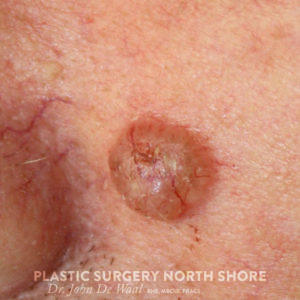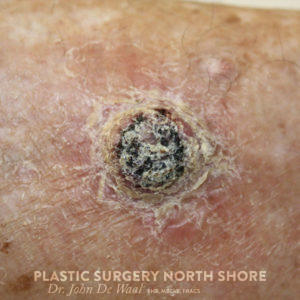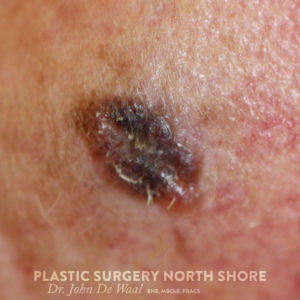Skin Cancer Removal
There are many types of skin cancers – each have their own peculiarities and so treatments vary.
Three main types of skin cancers however make up over 90% of all skin cancers.
- BCC (Basal Cell Carcinoma) – approx 60% of all skin cancers
- SCC (Squamous Cell Carcinoma) – approx 30% of all skin cancers
- Melanoma – approx 3% of all skin cancers
Skin cancers are very common . It is estimated there are about 70,000 new cases in New Zealand every year, making up about 80% of all new cancers in New Zealand
Of the 3 main types only melanoma is officially registered on the national cancer data base. With over 2000 new cases of melanoma (plus an additional 2000 cases of melanoma-in-situ) in NZ every year it accounts for over 10% of all newly registered cancers.
It is estimated approx 35% of the European population can expect to develop a BCC, about 10% a SCC and about 3% a melanoma over their lifetime.
Basal Cell Carcinomas are the most common skin cancers, they are also the least dangerous. They
- Can be red, pale or pearly coloured and flat, scar like or a lump in form.
- May ulcerate or bleed easily
- Usually grow slowly over many months
They rarely, if ever spread to other parts of the body from which they grow and so have an almost 100% cure rate once fully removed.
You can of course grow further BCC’s. They can also cause a lot of problem in the area they grow, especially if growing around eyes, behind ears or around the base of the nose.
CAUSE OF BCC’s
BCC’s have a strong association with both
- genetic / hereditary factors
- high UV exposure in early life
TREATMENT OF BCC’s
Mainly surgical but Early BCC’s away from critical areas (around the eyes, nose or ears) can sometimes be treated non-surgically by a variety of techniques including:
- Anti-cancer creams – Aldara and Efudix are two available on the NZ market
- Liquid Nitrogen
Squamous Cell Carcinomas usually behave like BCC’s when small but can spread to other parts of the bodies if they get big or in their more aggressive forms. They usually appear as a thickened, crusted area or lump that grows over several weeks to months.
CAUSE OF SCC’s
SCC’s usually arise in areas of sun damage. They are often preceded by the appearance of crusted damaged skin (Solar Keratoses).
Their appearance is strongly related to accumulated sun damage. For this reason sunscreens and other preventative measures play a very big part in minimising their appearance.
Theses arise from the pigment cells in the skin and are the most dangerous type of skin cancer.
They usually appear as an irregular freckle or mole that changes in colour, size or shape over a period of months. They are often flat in appearance. If untreated they will spread to other parts of the body. If treated early more than 95% can be cured.
TREATMENT OF MELANOMA – Surgery is the mainstay of melanoma treatment. Surgery is usually fairly aggressive and involves wide removal of the melanoma and pre-melanoma changes. For certain melanomas a ‘sentinel lymph node biopsy’ is sometimes also recommended. This provides very useful information on prognosis, follow-up and can determine funding access to certain new drug treatments.
There are some exciting new ‘chemotherapy’ type drugs which have been shown to have some effect on melanoma cells, causing some reversal and possibly cure in some cases.
Three main groups of drugs are currently being investigated and showing some promise include
- gene blocking therapies (BRAF/MEK inhibitors) – e.g. vemurafenib
- immune system stimulants – e.g. ipilimumab
- vaccine therapies – these vaccines act not to prevent disease but again act by revving up the immune system
In NZ, Pharmac approved funding for two drugs in 2016 – pembrolizumab (Keytruda) and nivolumab (Opdivo) – both ‘immune system stimulants’.




